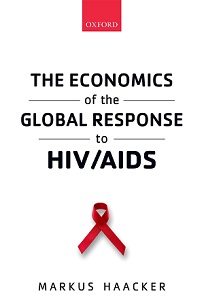The Economics of the Global Response to HIV/AIDS by Markus Haacker, Oxford: Oxford University Press, 2016, 290 pages.
The international response to HIV/AIDS ranks among one of the great public health stories in recent decades. Today's landscape is far different from the mid-1990s, when the successful application of combined antiretroviral therapies in wealthy nations was darkened by the news that the virus was rapidly spreading in countries too poor to afford such treatments. By 1996, 20 million people worldwide were living with HIV, with a large share in sub-Saharan Africa. By 2002, that number had spiked to 30 million. As Markus Haacker points out in his new book, The Economics of the Global Response to HIV/AIDS, the epidemic's impact has been so massive that it accounts for eight out of the 10 worst declines in life expectancy at a country level since 1950.
Thanks to billions of dollars in aid and an effective coordinated global response over the last 15 years, the rate of infections has dramatically slowed, and people who are infected can now expect to live close to a full life. But paradoxically, this success in health policy has led to an economic challenge for the nations that have been hard hit: how to pay for prevention and treatment in the long run. Haacker is well-positioned to address this, as a scholar who has spent years at the World Bank and the International Monetary Fund researching the economics of the HIV/AIDS crisis. His book lucidly explains what research has and has not been able to answer in this respect. And he usefully places this research in a global context rather than focusing on one or two countries, as work in this area often does.
AIDS policy researchers generally see 2001 as a tipping point when the international community scrambled to craft a coordinated response, leading to the expansion of efforts under the auspices of organizations such as UNAIDS and the Global Fund to Fight AIDS, Tuberculosis, and Malaria. The United States also began contributing as a major player in 2003, with the President's Emergency Plan For AIDS Relief, or PEPFAR. Those extra resources helped build a two-pronged approach. On the prevention side, promotion of condom use and male circumcision — as well as the targeting of certain high-risk groups — began cutting into HIV incidence rates. On the intervention and treatment side, drug companies agreed to cut prices of antiretroviral therapies in targeted countries so that they could be distributed to patients, including pregnant or nursing women who risked infecting their children, thereby reducing the chance of transmission.
By 2015, 16 million were receiving these drugs worldwide, and the average annual mortality rate dropped from 6.4 percent in 2004 to 3.2 percent in 2014. In South Africa, an infected patient can now expect a close to normal life span; in Botswana, the average HIV-related drop in life expectancy was once almost 20 years, and now it is five. The rate of HIV incidence, meanwhile, has greatly slowed; the total number of infected patients worldwide was 37 million in 2014.
This progress stands as a rebuke of sorts to the widespread pessimism of the 1990s. But the extent of the economic impact is still up for debate. Haacker emphasizes the need for more research on the macroeconomic effects, especially to answer some of the puzzles of the past 15 years. For example, some of the worst-hit nations — such as Kenya and Botswana — have maintained high per capita GDP growth rates despite the fact that both have a high share of citizens with HIV/AIDS. He also notes that most studies to date have not found a link between the spread of HIV/AIDS and an increase in poverty, although there is a stronger correlation with inequality.
An even more pressing concern for economists, in Haacker's view, is how to measure the cost-effectiveness of all of these strategies. Now that infected populations can live close to normal life spans, the cost of lifetime treatment needs to be accounted for as it would for any other chronic disease. The global budget for HIV/AIDS programs is now about $20 billion, $11 billion of which comes through external aid. Since prevention and treatment have become a long-term concern, an effective strategy can be sustained only if costs are controlled. In recent years, policymakers have been more explicit about using an investment framework, comparing expected rates of return on different approaches, to make allocation decisions. The challenge is that it takes decades to assess the impact of a strategy: An individual can move through different high-risk groups or try different prevention techniques over his or her adult life. That said, Haacker notes, some prevention measures — such as male circumcision and increased condom use — are so cost-effective and reliable that it makes sense to apply them as broadly as possible.
For any reader interested in the intersection between health and economics, Haacker's work is a comprehensive guide to one of the greatest public health challenges in history. It's also a valuable reminder that economics is just as important as medical science in crafting long-term strategies for managing chronic disease in large populations — something that policymakers everywhere will have to keep in mind as nations age in coming decades.




